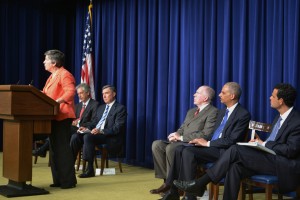
Members across federal agencies met at the White House Monday to unveil the new strategy to combat worldwide organized crime. Gina Harkins/MNS
WASHINGTON — The Obama administration’s new strategy to combat transnational organized crime gives the Treasury Department new sanctioning authority, but it also stresses more joint efforts among federal agencies in dealing with this growing threat to U.S. national security.
At a news conference announcing the strategy on Monday, John Brennan, assistant to the president for counterterrorism and homeland security, said the expanding size, scope and influence of transnational organized crime pose significant challenges.
“In the previous 15 years, transnational criminal networks have forged new and powerful alliances and are engaged in an unprecedented range of illicit activities that are destabilizing nations and populations around the globe,” Brennan said.
The White House estimates that annual costs and revenues generated by transnational organized crime groups make up 2 to 5 percent of the world GDP from money laundering, $750 billion to $1 trillion from narcotics trafficking and $500 billion from pirated products.
The strategy identifies crimes committed by these groups as:
- Co-opting some governments and weakening governance in others.
- Forging alliances with government elements including security services and big business figures.
- Undermining competition in strategic markets.
- Providing funding and logistical support for terrorist/insurgent activities.
- Stealing intellectual property.
- Expanding narcotrafficking and engaging in arms smuggling and human trafficking.
- Using cyber technologies to perpetrate sophisticated frauds.
“Societies have faced criminal threats throughout human history,” said William Burns, undersecretary of state for political affairs. “Today, however, we face globalized networks where terrorists and insurgent groups are turning to partnerships of convenience with criminal networks.”
The strategy included plans from the departments of State, Homeland Security and Treasury as well as legislation that, if passed, will enhance federal authorities’ ability to investigate and prosecute transnational organized crime.
Secretary of Homeland Security Janet Napolitano stressed the importance of interagency communication through border intelligence fusion centers, where officials gather intelligence and share it with other law enforcement agencies, both federal and local. Shelley said the administration’s strategy focuses on the U.S.-Mexico border more than in the past due to the increase of drug cartels and threats on that border.
Napolitano also cited the need for international partnerships, which she said are “essential to combatting what is fundamentally a transnational problem.”
Dr. Louise Shelley is the founder and director of George Mason University’s Terrorism, Transnational Crime and Corruption Center, emphasized the need to continue public-private partnerships, which the strategy also mentions. The administration is concerned about the increase in counterfeit pharmaceuticals.
“There is a lot of cooperation from the pharmaceutical companies, so that is an example of a successful public-private partnership,” she said. “There is a real concern about counterfeits including cigarettes, purses, DVDs and electronics parts that contribute to auto and aviation safety. These are run by these organizations.”
Shelley said the U.S. can learn from its international partners, especially in methods of letting suspects of organized crime know they’re being watched.
“One tactic I love used by the British is to send those identified as serious organized criminals a birthday card to let them know they’re being watched,” she said. “’Happy birthday from the Serious Organised Crime Agency,’ it will say. If people know they’re being watched, it helps contain crime.”
She said representatives from the Obama administration have attended her center’s seminars on transnational crime, but discussion of how to deal with the problem has been going on since President George W. Bush was in office.
“The approach has become more interagency than it was under the Bush administration,” Shelley said. “The more coordination there is, the more effective a strategy is. Having many people working together on an issue like this fills the holes.”
